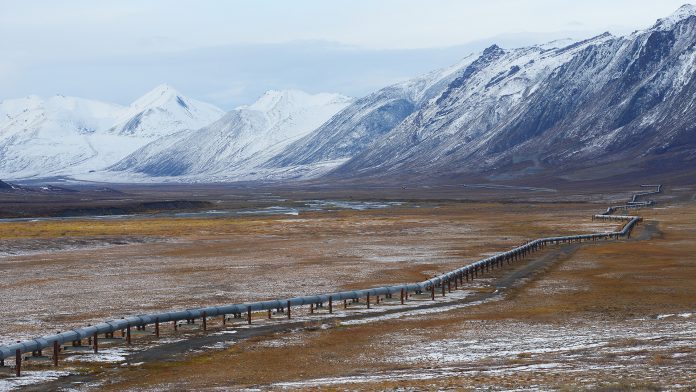
In an op-ed that ran in the Alaska Dispatch News, Carl Portman, deputy director of the Resource Development Council for Alaska, and David Holt, president of Consumer Energy Alliance, discuss how Gov. Bill Walker and Sen. Dan Sullivan can galvanize support for sustainable Alaskan energy among the Lower 48 state governors and all members of Congress.
With elections behind us, it’s time to get to the business of growing Alaska’s economy. A principal part of any strategy must include proactive policies that will reverse the decline in Alaska energy production.
Alaska has suffered a dramatic decline in recent decades in part due to federal regulatory uncertainty and litigation in our critical energy industry. Whereas the Lower 48 has seen energy production shoot up 77 percent in the last five years, due largely to state and private ownership of mineral rights, Alaska’s average oil production has plunged from more than 2 million barrels per day in the late 1980s to approximately 540,000 today — dropping the state to fourth nationwide in production.
Years of governmental reviews, litigation and regulatory uncertainty have turned a top domestic source of oil into one being outdone by California, a state that has considered banning fracking and said no to offshore drilling. It now produces more oil than Alaska.
Considering that at least 34 percent of Alaska’s jobs and more than 80 percent of the state’s discretionary spending are dependent upon the petroleum industry, it’s clear that reviving and encouraging the energy industry here is a key to our future.
Our new leaders — including Gov. Bill Walker and Sen.-elect Dan Sullivan — will soon learn that efforts to grow Alaska energy must also take place outside Juneau. Much of their job must include advocating to their Lower 48 peers, given so much of Alaska’s resource base is under federal ownership.
Alaskan voters overwhelmingly want an “all of the above” approach to energy — supporting everything from wind energy to allowing oil and natural gas production in U.S. waters inside the Arctic Circle and in the Arctic National Wildlife Refuge. Without greater access to abundant federal resources onshore and offshore, the future of Alaska energy — and the revenues and jobs it supports — is in jeopardy.
While most Alaskans have been up in arms about the Alaska energy shutout on federal lands and waters, the rest of the United States has remained either silent or unaware. It’s not a stretch to think that Lower 48 disinterest could be the reason, or even a catalyst, for these restrictive federal policies. If no one’s talking, no one’s listening.
Sen.-elect Sullivan and Gov. Walker need to invest some sweat equity educating other members of Congress and governors about how critical Alaska energy is to Lower 48 consumers.
For starters, they should inform Lower 48 consumers on the benefits of Alaska energy. According to the American Petroleum Institute, by permitting onshore and offshore oil and natural gas exploration now, by 2030 new Alaska production could reach 1.6 million barrels of energy equivalent a day. West Coast residents — who consume a vast majority of Alaska’s oil — should support Alaska development. If further declines in production occur, West Coast refineries’ reliance on imported oil will only grow, leaving consumers more vulnerable to supply disruptions that are the norm in unstable oil-exporting countries.
Our leaders should also expound on the national security benefits of Alaska energy. Nearly every member of Congress was not in office during the oil embargoes of the 1970s and the building of the trans-Alaska pipeline. In fact, most members of Congress came to Washington within the past decade and have legislated during an era of U.S. energy abundance and increasing self-sufficiency. However, we must not take our present reality for granted. Taking actions now to encourage federal offshore and onshore production in Alaska will help preserve our gains in energy security for decades to come.
An estimated annual average of 54,700 new jobs that would be created by outer-continental-shelf-related development (OCS) are sustained for 50 years. The total ramps up to 68,600 during production and 91,500 at peak employment. These direct and indirect jobs would be created both in Alaska and the rest of the United States.
Alaska’s energy generates revenue and jobs for Lower 48 residents, too. A Northern Economics report estimates an annual average of 54,700 new jobs that would be created by OCS-related development would be sustained for 50 years. An estimated $63 billion in payroll would be paid to employees in Alaska as a result of OCS oil and gas development and another $82 billion in payroll would be paid to employees in the rest of the United States.
The sustained job creation increases income and further stimulates domestic economic activity.production on federal land and waters and will also send billions of dollars to federal coffers, some of which will be redistributed to state governments and to the Federal Land and Water Conservation Fund, which benefits every state. With regard to Alaska, our congressional delegation will need to secure the state’s fair share through revenue-sharing provisions which already apply to Gulf states that have energy production off their shores.
By galvanizing support for Alaska energy among other governors and members of Congress, Alaska’s leaders can bring attention to the need for policies that support responsible energy development. The louder our voice, the harder it will be for Washington to ignore us.
Carl Portman is the deputy director of the Resource Development Council, based in Anchorage.David Holt is the president of the Consumer Energy Alliance.









